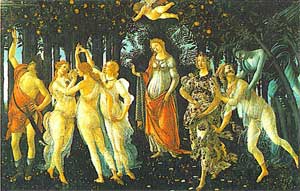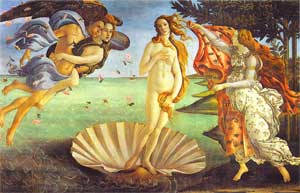Botticelli - Primavera and The Birth of Venus
Sandro Botticelli’s “Primavera” or the “Allegory of Spring” reveals a strange and ambiguous beauty. Together with other mythological and allegorical paintings, it was created for Lorenzo di Piero Francesco’s newly bought villa at Castello. The “Allegory of Spring” and “Pallas and the Centaur,” were painted in 1482, the “Birth of Venus in 1485.” For him Botticelli also executed the Dante illustrations. The artist relation with his patron lasted some twenty years, corresponding to Sandro’s most precious and characteristic work.
In contrast, his relations with the ruling Medici, and especially with Lorenzo the Magnificent, are quite insignificant. Except the commissions for the Sistine Chapel, no others will come close in importance to those undertaken for Castello and its master.

Sandro Botticelli - Primavera, 1482
Uffizi, Florence
”Primavera” is purely literary and classical. Cupid, Venus, Flora, Spring, and Zephyr, actually all the figures on the right hand side of the picture, are borrowed from Lucretius. To confirm, we can read in the fifth book of De Rerum Natura a splendid passage in which Venus is represented as she who renews all life through recurring springs.
“Primavera” is only less literary than the “Calumny of Apelles.” Its strange beauty is individual. The artist was absorbed in a dissolving Tuscan spring, resolving itself into a distant garden of Venus, an antique paradise, composed, after all, of dear, local Tuscan materials, and peopled by the little girls and youths of Florence, raised to a momentary divinity.
The orange stand of trees seems an elaborated metal bas-relief, completely unusual for the Florentine art of the period, a reminder of a late Gothic decorative motive.
The companion piece, the “Birth of Venus,” was created a few years later. According to the legend, the picture was painted for Lorenzo de’ Medici, and the figures are representing real persons. It is said that Mercury is the unfortunate Guliano, and Venus the fair Simonetta, his love, who have sat for many of Botticelli’s pictures. Her transparent, fragile beauty is said to have haunted Botticelli for many years after her death.
We do not know for sure if this is true, and it is possible that the relations between Giuliano and Simonetta Vespucci were merely ceremonious. What we know for sure is that Giuliano, wearing her colors as a compliment, won the midsummer joust of 1475. As the poets were glorifying the champion, she died, and the same writers took advantage in adding an elegiac note to their chivalric poems. The assassination of Giuliano himself, in the flower of his youth, gave pathetic credence to such rhetoric.
Critics may prefer one picture or the other. Lovers of the fantastic, essential Botticelli, will prefer “Primavera” for the richness of its contents, the varied impressions it relays, and the general romantic treatment.

Botticelli - The Birth of Venus, 1485
Uffizi, Florence
The more classically inclined will find a higher satisfaction in the simpler and more unified impression of the “Birth of Venus,” in the more advanced and purposeful rendering of the landscape, in its harmony of somber colors of gray, olive, pale blue, and rose, with fine tracery of gold, and in the melancholy of the virgin goddess.
Motion, reinforced by the symmetry of color is the main impression one gets from “Primavera” and “Birth of Venus.”
No other among the Renaissance painters has Botticelli’s grace and charm, none his lightness of touch; no one can portray wind and floating draperies and the feeling of air and motion as he does, and above all, none can infuse into grace and beauty that touch of yearning and wistfulness.
And it is the finer use of brush in masses that distinguish Botticelli from Antonio Pollaiuolo.
“Primavera” shows an amazing arrangement of line, and this may be said to be a linear quality. Botticelli was even named the master of a single line. But he uses it to outline the figure contour, a fold or a hand, everything done with a unique rhythm, not equaled in the Florentine art. This movement is reinforced by contrasts as the shivering drapery of Flora, or the heavy folds of Venus’s robes, caught against the dancing forms of the Graces.
The diaphanous nature of Graces’ vestments, when compared with the linear framework of the great and lovely picture, is akin of a cascade in a mountainous vale.
Like in all other Botticelli’s mature works, especially the Vatican frescoes, we see a magic brush powerfully enhancing the value both of the expressive contour and of the dynamic line.
Whether he is working on the classical, the allegorical or the Dantesque, he sees things in his own way.
Sandro Botticelli was before all things a poetical painter, blending the charm of the art of poetry, with the charm of color of his abstract painting.
More about Boticelli: His biography and paintings